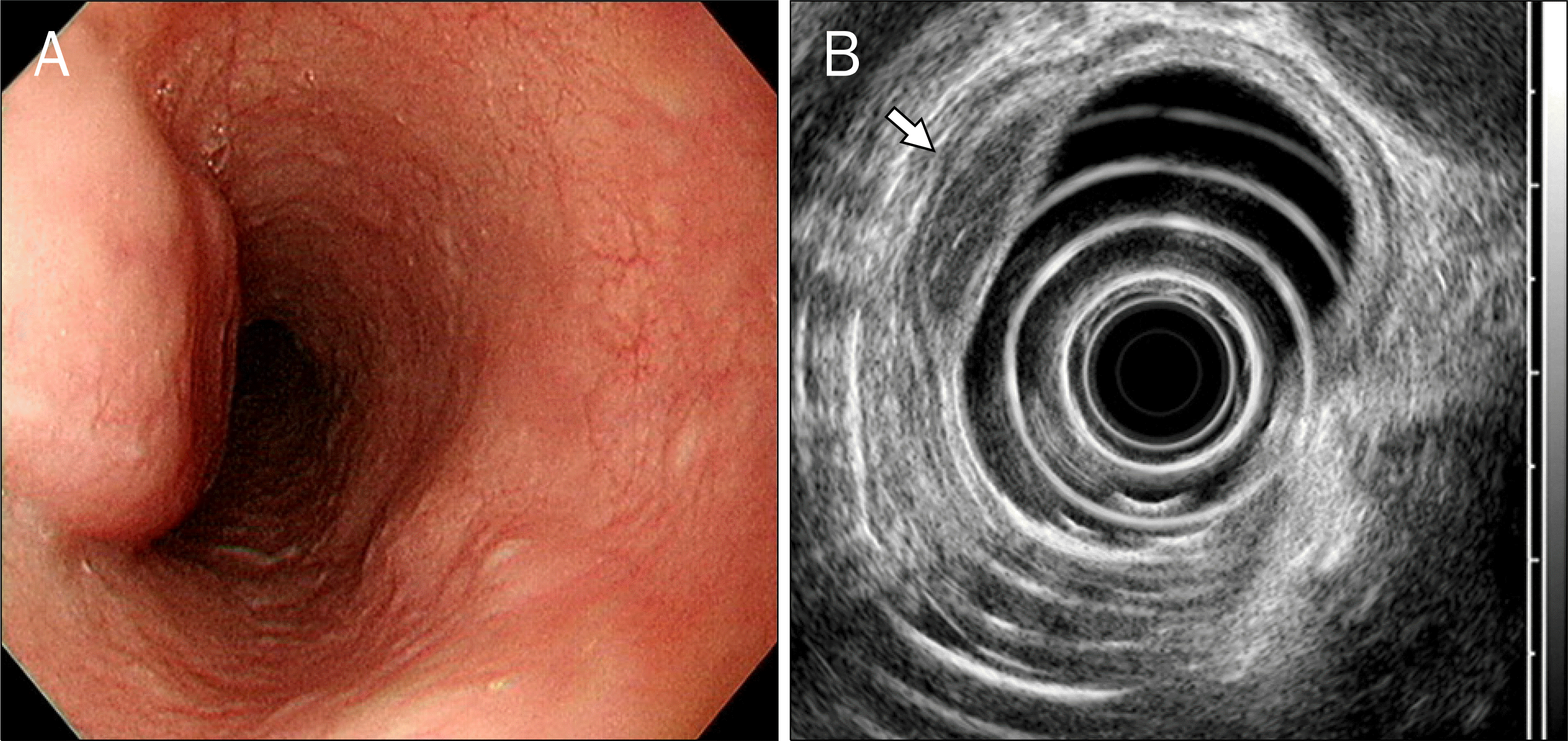Abstract
We report a case of primary mucosa-associated lymphoid tissue (MALT) lymphoma in the esophagus that manifested as a large submucosal tumor (SMT). Primary esophageal lymphoma is very rare, occurring in less than 1% of all patients with gastrointestinal lymphoma. Only a few cases of MALT lymphoma in the esophagus have been reported in the English literature. A 53-year-old man was referred to Dongguk University Ilsan Hospital (Goyang, Korea) in July 2012 for further evaluation and treatment of an esophageal SMT. Endoscopy showed a cylindrically elongated submucosal mass with normal overlying mucosa in the mid esophagus, 25–30 cm from the incisor teeth. He underwent surgery to confirm the diagnosis. Pathologic findings showed diffuse small atypical lymphoid cells which were stained with Bcl-2, CD20, but not with CD3, CD5, CD23, Bcl-6, or cyclin D1. These cells showed a positive monoclonal band for immunoglobulin heavy chain gene rearrangement. Based on the pathological, immunohistochemical, and molecular biological features, the esophageal mass was diagnosed as extranodal marginal zone B-cell lymphoma of the MALT type.
Go to : 
References
1. Isaacson P, Wright DH. Malignant lymphoma of mucosa-associated lymphoid tissue. A distinctive type of B-cell lymphoma. Cancer. 1983; 52:1410–1416.

2. Freeman C, Berg JW, Cutler SJ. Occurrence and prognosis of extranodal lymphomas. Cancer. 1972; 29:252–260.

3. Amer MH, el-Akkad S. Gastrointestinal lymphoma in adults: clinical features and management of 300 cases. Gastroenterology. 1994; 106:846–858.

4. Herrmann R, Panahon AM, Barcos MP, Walsh D, Stutzman L. Gastrointestinal involvement in non-Hodgkin's lymphoma. Cancer. 1980; 46:215–222.

5. Taal BG, Van Heerde P, Somers R. Isolated primary oesophageal involvement by lymphoma: a rare cause of dysphagia: two case histories and a review of other published data. Gut. 1993; 34:994–998.

6. Harris NL, Jaffe ES, Diebold J, et al. The World Health Organization classification of neoplastic diseases of the hematopoietic and lymphoid tissues. Report of the Clinical Advisory Committee meeting, Airlie House, Virginia, November, 1997. Ann Oncol. 1999; 10:1419–1432.
7. Hyjek E, Isaacson PG. Primary B cell lymphoma of the thyroid and its relationship to Hashimoto's thyroiditis. Hum Pathol. 1988; 19:1315–1326.

8. Weston AP, Cherian R, Horvat RT, Lawrinenko V, Dixon A, McGregor D. Mucosa-associated lymphoid tissue (MALT) in Barrett's esophagus: prospective evaluation and association with gastric MALT, MALT lymphoma, and Helicobacter pylori. Am J Gastroenterol. 1997; 92:800–804.
9. Chung JJ, Kim MJ, Kie JH, Kim KW. Mucosa-associated lymphoid tissue lymphoma of the esophagus coexistent with bron-chus-associated lymphoid tissue lymphoma of the lung. Yonsei Med J. 2005; 46:562–566.

10. Hayashi M, Ueda K, Tanaka T, et al. Mucosa-associated lymphoid tissue (MALT) lymphoma arising in the esophagus, stomach, and lung. Gen Thorac Cardiovasc Surg. 2011; 59:826–830.

11. Hosaka S, Nakamura N, Akamatsu T, et al. A case of primary low grade mucosa associated lymphoid tissue (MALT) lymphoma of the oesophagus. Gut. 2002; 51:281–284.

12. Kishi K, Maeda H, Nakamura Y, Shirai S, Sato M. Radiotherapy for mucosa-associated lymphoid tissue (MALT) lymphoma of the esophagus: a case report with a diagnostic and therapeutic discussion. Int J Clin Oncol. 2012; 17:174–180.

13. Kitamoto Y, Hasegawa M, Ishikawa H, et al. Mucosa-associated lymphoid tissue lymphoma of the esophagus: a case report. J Clin Gastroenterol. 2003; 36:414–416.

14. Miyazaki T, Kato H, Masuda N, et al. Mucosa-associated lymphoid tissue lymphoma of the esophagus: case report and review of the literature. Hepatogastroenterology. 2004; 51:750–753.
15. Shim CS, Lee JS, Kim JO, et al. A case of primary esophageal B-cell lymphoma of MALT type, presenting as a submucosal tumor. J Korean Med Sci. 2003; 18:120–124.

16. Soweid AM, Zachary PE Jr. Mucosa-associated lymphoid tissue lymphoma of the oesophagus. Lancet. 1996; 348:268.

17. Yano S, Usui N, Dobashi N, et al. A case of primary esophageal mucosa-associated lymphoid tissue lymphoma with a numerical abnormality of 18q21 detected by fluorescence in situ hybridization. Ann Hematol. 2009; 88:703–704.

18. Nishryama Y, Yamamoto Y, Ono Y, et al. Visualization of esophageal non-Hodgkin's lymphoma with Ga-67 scintigraphy. Ann Nucl Med. 1999; 13:419–421.

19. Ogura T, Tajika M, Hijioka S, et al. First report of a mucosa-associated lymphoid tissue (MALT) lymphoma of the esophagus diagnosed by endoscopic ultrasound-guided fine-needle aspiration (EUS-FNA). Endoscopy. 2012; 44(Suppl 2 UCTN):E167–E168.

20. Alpen B, Neubauer A, Dierlamm J, et al. Translocation t(11;18) absent in early gastric marginal zone B-cell lymphoma of MALT type responding to eradication of Helicobacter pylori infection. Blood. 2000; 95:4014–4015.
Go to : 
 | Fig. 1.Endoscopic findings. (A) Endoscopic observation shows a cylindrically elongated submucosal mass in the mid esophagus (25–30 cm from the incisor teeth). (B) Endoscopic ultrasonography shows an ovoid homogenous hypoechoic mass (arrow) originating from the third hyperechoic layer (submucosa). |
 | Fig. 2.Chest computed tomography findings. (A) There is a mediastinal solid mass arising from the esophagus wall (arrow). Its density is homogenous. (B) Sagittal reconstruction view shows a well-circumscribed longitudinal mass, following the path of the esophagus (arrow). There is a posterior displacement of the esophageal lumen by the mass. |
 | Fig. 3.Pathologic features. (A) Diffuse infiltration of atypical lymphoid cells occupying the marginal zone of the lymphoid follicle (H&E; left, ×12.5; right, ×100). (B) Positive immunoreactivity for the bcl-2 protein (immunohistochemistry, ×200). (C) Positive immunoreactivity for the CD20 protein (immunohistochemistry, ×200). |
Table 1.
Clinical Findings of Reported Primary Esophageal MALT Lymphomas
MALT, mucosa‐ associated lymphoid tissue; MCTD, mixed connective tissue disease; Tbc, tuberculosis; U, upper; M, middle; L, lower; ND, no description in the original reports; SMT, submucosal tumor; CHOP, cyclophosphamide, doxorubicin, vincristine, and prednisolone; R‐ CHOP, rituximab, cyclophosphamide, doxorubicin, vincristine, and prednisolone; EMR, endoscopic mucosal resection.




 PDF
PDF ePub
ePub Citation
Citation Print
Print


 XML Download
XML Download